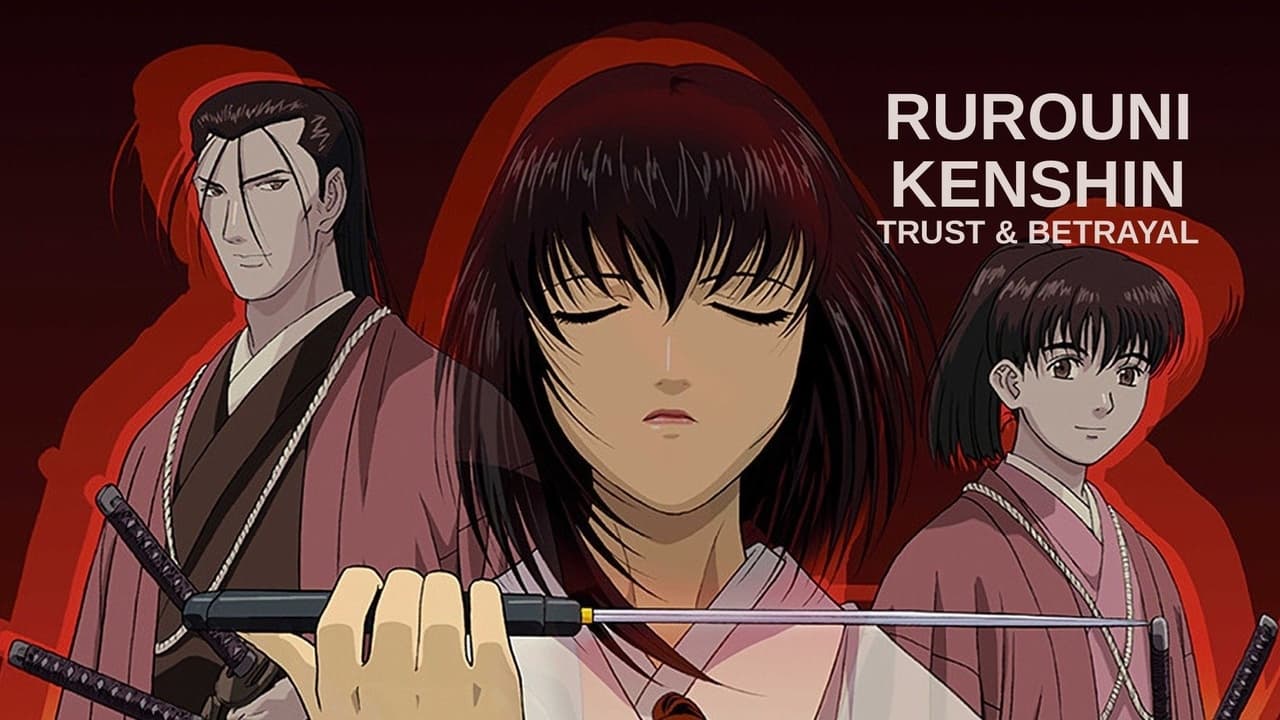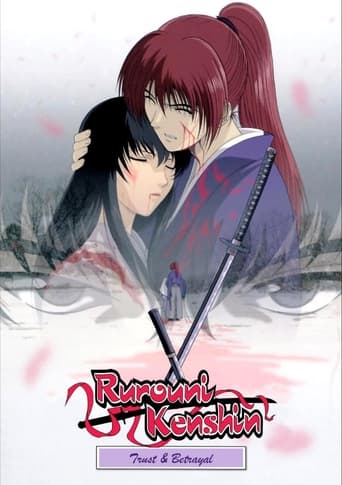

Good concept, poorly executed.
... View MoreDisturbing yet enthralling
... View MoreA film of deceptively outspoken contemporary relevance, this is cinema at its most alert, alarming and alive.
... View MoreOne of the best movies of the year! Incredible from the beginning to the end.
... View MoreIf there is one word adequate for describing "Ruroundi Kenshin: Tsuioku-hen", it would be "inconsequent". Although the story, storytelling and animation all suffer from a lack of balance, there are faint glimmers of brilliance to be found in the mini-series, explaining it being frequently mistaken for one of the masterpieces of Japanese animation.The first of four episodes serves as backstory for the backstory for the main plot, and with "backstory" (the first "backstory that is, for a lot more backstory is coming) I mean the protagonist's complete character development over the course of a small decade, conveyed through half an hour of exposition of differing subtlety and clarity. To keep the episode interesting, the chronology has been stirred somewhat by cutting between timelines, which mostly has the contrary effect of making the story feel convoluted, especially noting the shipments of minor characters dumped onto the screen with little introduction and the possibility of never showing up again.The second episode provides the more recent backstory, centering around the shogun wars during the late nineteenth century. Considering all of this is background information for the personal conflict of the second half of the series (the one with a plot), it should be noted a lot of time is spend on oblique dialogue concerning the geopolitical situation in Japan, which is mostly irrelevant for the central conflict. At the same time, the second episode features more action than the first, but most of it is disappointing. In my experience, the audience is usually interested in being able to *see* the action, besides a few flashes of blood (or tomato juice, for as far I could distinguish) illuminating the dark sky, and covering the dark streets, dark houses and dark corpses. And intercutting the fighting with stroboscopic black screens is not a way to heighten the tension, for the presumed majority of viewers who do not suffer from epileptic disease, that is.The third episode is the one that finally gets to the main plot, and the first episode to actually be good. The awkward action and shogun politics are brought to the background, shifting the focus to inner- and personal conflict. The protagonist's struggle with the question whether blindly killing people is truly the best way to create a better world (superficial as this conflict may be) is beautifully represented by the leitmotiv of a continuously reopening wound on his cheek, while the interaction with the woman he is sheltering with is subtle and believable. Their conversations always have an complex undertone of love, grief, doubt and fear, without directly addressing those matters. The audience is not informed of how their relationship develops, but shown through the sophisticated interactions, which is how the potential of film as a medium is fully realised. For a delightful thirty minutes, "Ruroundi Kenshin: Tsuioku-hen" was actually great.After the sudden increase in quality during the third episode, I bade: "Please, let the last episode not just be sword fighting and shameless melodrama." How I hate to be right. The deliberate understatement has been traded in for operatic betrayal and misconception, combined with the first two episodes' action, luckily somewhat more bearable because of the lighter backgrounds. The final episode still is a melancholic portrait of a samurai's stoicism, but ultimately, "Ruroundi Kenshin: Tsuioku-hen" has ruined its opportunity of nuance.The animation is hit-and-miss as well. Some characters look more realistic than usual for the medium, while others look like walking fish, with appropriate lip movement. The backgrounds are plagued by a similar imbalance: the ones are not obscuring brown and oppressive grey, are so brightly coloured they interfere with the characters, making the frames feel unbalanced, as it is difficult to decide where to focus."Ruroundi Kenshin: Tsuioku-hen" is cobbled together from ill-fitting elements, most of which were not very good in the first place. The mini-series has moments of beauty and even shimmers of genius, mostly in the third episode, but the structural ineptness undermines the impact, as the first half is tedious set-up and the second lacks decent pay-off. Many lessons can be learned from its triumphs and mistakes, and it should be watched by fans of the medium, although a certain moderation in critical response would be appropriate.
... View MoreOne of the masterpiece of animation which will touch your hart. I saw all the episode of the Rurouni Kenshin. Who ever watched the series knows the Battousai the man slayer. But how he became legendary man slayer is not shown in the Series. To know it you should watch this movie. The complex emotion of Love and Haterate is shown in this movie and executed superbly. How Rurouni Kenshin got the x mark on his face is showed in this movie. I liked this movie. It is very touching and make you feel the power of love. The best part of the movie it will not make you bore.I saw so may animated movies and I love animated movies. But this one I added in my best animation list. The only reason I have given rating 9 because the emotions in this movies is shown beautifully. it is very difficult to mix emotion with the violence or fights. but In this move it is beautifully executed
... View MoreIs living life just an atonement for ones past sins? This is the tragedy of Kenshin's life. A good soul forced into doing wickedness by others. By committing these acts he has damned his soul forever and it cannot be easily atoned for or forgotten. So he is forced to wander and to do good as penance for his evil past. Plot: Years later, during his time as a Hitokiri, Kenshin kills a bodyguard named Kiyosato Akira, who is the fiancé of Yukishiro Tomoe. The encounter with Kiyosato leaves Kenshin with the first half of his cross-shaped scar. After fighting with another assassin, Kenshin meets Tomoe. When Kenshin's cover as the shadow Hitokiri is blown, Katsura arranges for Kenshin and Tomoe to hide in the village of Otsu as husband and wife, so the two would not be suspected.After a few months, Tomoe's brother Enishi comes to visit and secretly reveals to his sister that the shogunate spies assigned to track down and kill Kenshin are close by, and that her revenge will be complete. Tomoe sends Enishi off, feeling ill at ease. It is here that Tomoe realises that she has fallen in love with Kenshin. The next day, Tomoe leaves the house and tries to persuade the shogunate men to give up their pursuit of Kenshin.Will Tomoe succeed? Will Kenshin find happiness with Tomoe? See this wonderful anime film and find out.This film is not suitable for children and persons under the age of 18 as it contains graphic killing sequences.This film is good viewing for married couples and those who have been just married, as it shows just how true love between husband and wife should be.10/10, excellent. An unforgettable story.
... View MoreFirst and foremost my goal is to write a review about a movie, not an anime. Many people consider this one of the greatest anime ever made but it kind of saddens me that people only treat it as an anime and recommend fans of anime to watch it. I see Kenshin OVA Trust/Betrayal as a movie and recommend every movie fan to watch it.If you are looking for a summary, read somewhere else. If you are trying to find out why this is a great movie, I will try my best to convince you.Kenshin OVA is a character driven movie with excellent character development. The two main characters, Kenshin and Tomoe, have humane and non exaggerated personalities, they are conflicted with their emotions, and they grow and change. I guess what I am trying to say is that the two main characters are not cliché.The stories' setting takes place during the late 1800's in Japan, where a civil war is taking place, where the samurai era is coming to an end, and the shogunate is fighting to keep its place. People who don't know Japanese history of that time period probably going to get a bit confused, but the historical setting provided the movie more depth and political intrigue. Like the current trend of war movies, the historic conflicts are not presented in black and white, but rather shades of gray.The action sequence is something to behold of. It is violent, gruesome, bloody, but does not feel gratuitous, due to the mood and setting the animators have created. The sword fights short, but quick, intense, believable (realistic), and original in presentation. Far better than any live action choreography.Finally there are many subtle touches that makes the movie feel more like a work of art, rather animated violence. The animators are created a lot of scenes with nature. Whether it is the subtleness of snow flake or sakura leaves falling, or the glistening of the lake from the sun, the animators created a world of beauty. On top of that, the soundtrack just masterfully sets up the mood of the scene. The soundtrack is haunting, kinetic during battle, and subtle and poignant. Most importantly the soundtrack is memorable.Kenshin OVA Trust/Betrayal is on the top tier of anime, however if the movie had gotten greater exposure, it would belong in the top tier of movies.
... View More